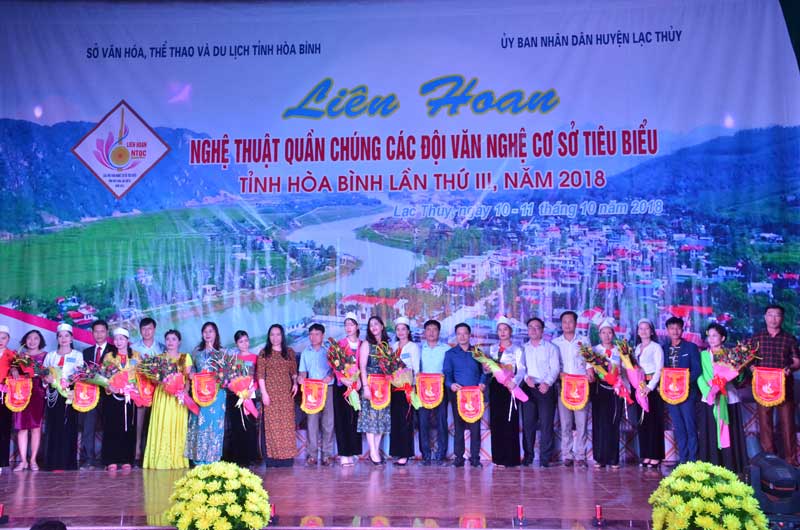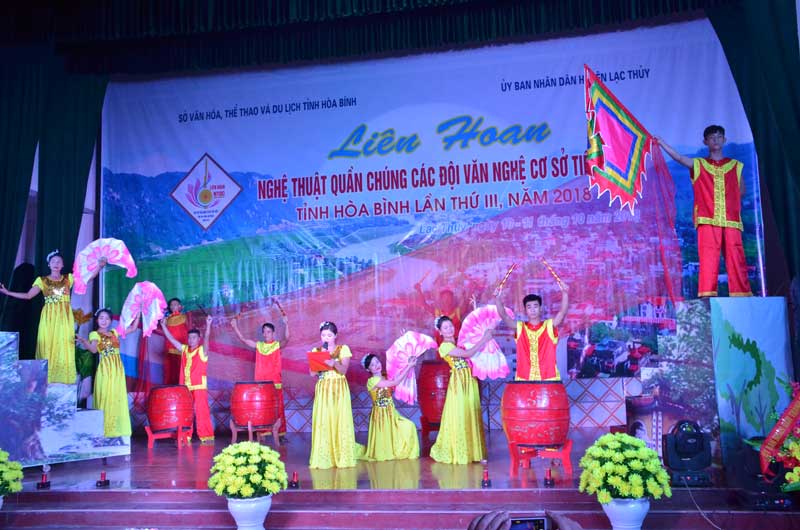
(HBO) – The Department of Culture, Sports and Tourism of Hoa Binh recently held the 2018 art festival for the province’s outstanding grassroots-level art troupes, in Lac Thuy district.

Organisers
present memorial flags to participating troupes.

Performance
of the art troupe in Vai hamlet, Thanh Nong commune (Lac Thuy district)
Nearly 300 artists, actors and actresses from 11 outstanding grassroots-level
art teams in 11 districts and cities participated in the festival. They
represented more than 2,000 art troupes in all villages, hamlets and
residential clusters in Hoa Binh province.
During the two-day event, the art troupes staged nearly 40
performances praising patriotism, the Communist Party of Vietnam and President
Ho Chi Minh, and the national target programme on building new-style rural
areas.
According to organisers, the performances this year were of better
quality compared to the previous edition, as the teams had thoroughly prepared
content, costumes, and props. Each programme was built on a consistent theme
which is close to people’s lives.
Notably, most of the troupes used folk melodies, dances and
traditional music instruments in their performances, thus creating a colourful
art festival which aimed to honour, preserve and develop traditional cultural
values.
At the end of the festival, organisers presented four first prizes,
eight second, and 12 third prizes, along with 12 consolation prizes in singing
and dancing categories.
In general, the first prize was granted to the art troupe from Vai
hamlet, Thanh Nong commune (Lac Thuy district).
Those from Moi Mit hamlet of Yen Mong commune (Hoa Binh city) and
Du 7A hamlet of Mong Hoa commune (Ky Son district) received second prizes.
The third prizes were given to troupes from Van hamlet, Mai Chau
town (Mai Chau district), Lien Tien hamlet in Ngoc Luong commune (Yen Thuy
district), and Ma hamlet, Bac Phong commune (Cao Phong district) while five
consolation prizes were presented to the remaining teams./.
The People’s Committee of Lac Son district held a ceremony on April 28 to receive the provincial relic certificate for the ancient rock carving site at Suoi Co stream, located in My Thanh commune.
A special music show titled "The country is in the fullness of joy” has been held at Hoa Binh Square in Hoa Binh city in celebration of the 50th anniversary of the liberation of the South and national reunification (April 30, 1975–2025).
The People's Committee of Lo Son commune, Tan Lac district, has organised the local annual traditional stream fishing festival on April 19 - 20.
As a land deeply intertwined with human history and Vietnam’s millennia-long journey of nation-building and defence, Hoa Binh is often revered for its epic tales and legends.
Residents of Hoa Binh boast a rich cultural identity, reflected in their unique language, traditional attire, customs, and folk melodies – described as "sweet as honey, clear as a mountain stream.”
Lac Son district’s Vu ban town held the 2025 Truong Kha temple festival on April 12–13 (the 15th–16th days of the third lunar month). Since its revival in 2019, the festival has been organised every three years, preserving valuable intangible heritage while meeting the community’s cultural and spiritual needs.




